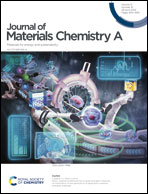A highly conductive and ultra-stretchable polyaniline/cellulose nanocrystal/polyacrylamide hydrogel with hydrophobic associations for wearable strain sensors†
Abstract
Despite tremendous attention to hydrogel-based wearable strain sensors, it is still challenging to develop an all-in-one hydrogel possessing desired properties of ultra-stretchability, extraordinary conductivity and high strain sensing. Herein, instead of conventional chemical cross-linking, polyacrylamide (PAAm) hydrogel is cross-linked with hydrophobic association (HA), and is further reinforced with cellulose nanocrystals (CNCs), yielding a robust HAPAAm/CNC hydrogel. Subsequently, the HAPAAm/CNC is sequentially immersed into acidic solutions with various concentrations of aniline and initiator (0.5 M is optimal), leading to polymerization of aniline monomers inside the hydrogel. The optimal hydrogel (HAPAAm/CNC/polyaniline (PAni)-0.5), has great stretchability (≈2400%) and skin-like Young's modulus (30 kPa). It also shows outstanding electrical conductivity (21.7 S m−1), thanks to conductive pathways provided by PAni nanofibers. Such a combination of great mechanical and electrical properties has never been reported for PAni-based hydrogels. The resultant hydrogel can sense strains as low as 1%, while also measuring strains up to 1000%. Besides having linearity, the hydrogel sensor has a high gauge factor (GF = 3.7) within a range of 0–200%, exceeding that of many reported PAni-based hydrogel sensors. The hydrogel sensor can detect human motions from large strains to minor ones (e.g., breathing). Therefore, HAPAAm/CNC/PAni-0.5 shows great promise for soft electronics.



 Please wait while we load your content...
Please wait while we load your content...